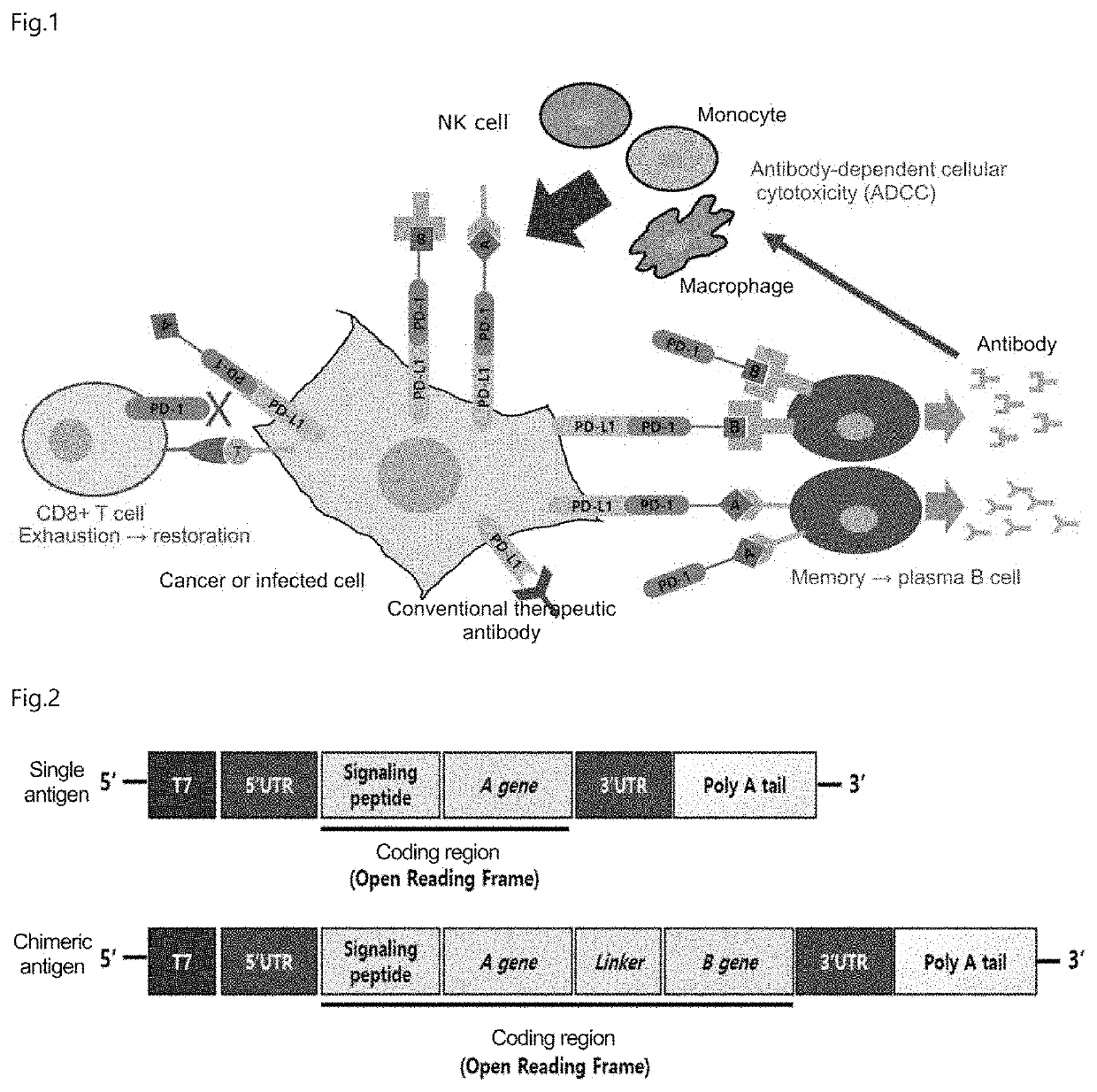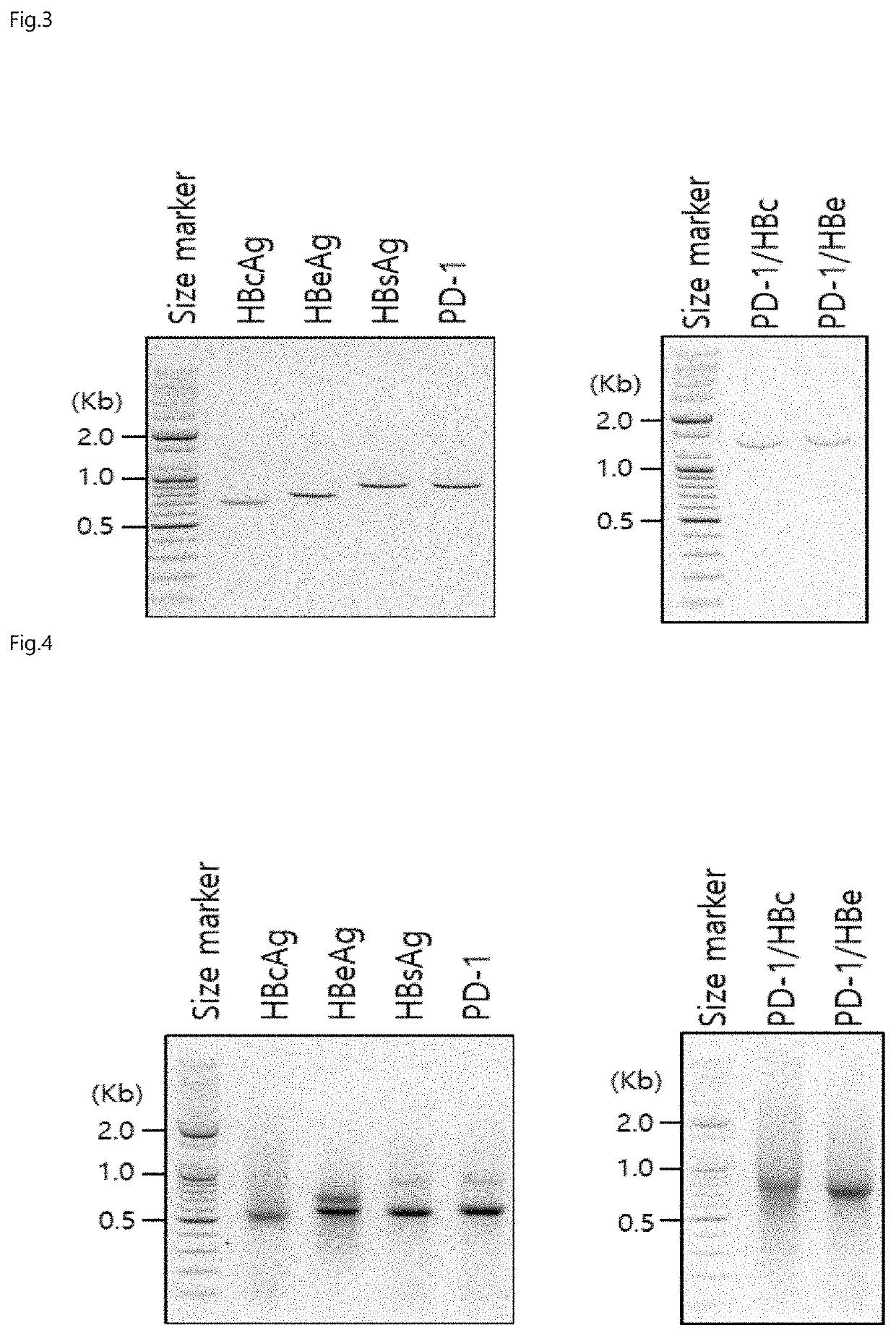Chimeric antigen with enhanced multi-immune function through specific binding to target cell, and use thereof
a technology of chimeric antigen and target cell, applied in the field of chimeric antigen, can solve the problems of significant physiological burden, immune response may reach a stalemate, and develop defects in germ- and tumor-fighting capabilities, and achieve the effects of enhancing multiple immune functions, and promoting cell activation
- Summary
- Abstract
- Description
- Claims
- Application Information
AI Technical Summary
Benefits of technology
Problems solved by technology
Method used
Image
Examples
example 1
[0103]Production of Fusion Gene Encoding HBc, HBe, HBs, PD-1 / HBc or PD-1 / HBe Chimeric Antigen
[0104]FIG. 2 shows a schematic view of a DNA fragment for producing an IVT mRNA (in vitro transcribed mRNA) by in vitro transcription of each gene encoding each of hepatitis B core antigen protein (HBcAg), hepatitis B e antigen protein (HBeAg), hepatitis B surface antigen protein (HBsAg), PD-1, and soluble chimeric antigens PD-1 / HBc and PD-1 / HBe. As shown in FIG. 2, the DNA fragment for producing the IVT mRNA was constructed with reference to an mRNAExpress mRNA Synthesis kit (System Biosciences, USA) so as to contain an open reading frame, a T7 promoter nucleotide sequence, a 5′ untranslated nucleotide sequence (5′UTR) and a 3′ untranslated nucleotide sequence (3′UTR). The DNA fragment was designed such that the open reading frame (i.e., the target gene) was linked and inserted in a cassette form. At this time, the order of the open reading frames encoding the immune response-inducing domai...
example 2
[0109]Synthesis of IVT mRNA from DNA Fragment Encoding Single Antigen or Chimeric Antigen
[0110]Artificial mRNA was synthesized by in vitro transcription using the template DNA produced in Example 1, and this synthesis was performed using the HiScribe T7 ARCA mRNA kit with tailing (New England Biolabs, USA), an mRNA production kit. Specifically, 1 μg of each purified DNA fragment containing the nucleotide sequence of the single or chimeric antigen gene of each of HBcAg, HBeAg, HBsAg, PD-1, PD-1 / HBc and PD-1 / HBe, 10 μl of 2×ARCA / NTP mix and 2 μl T7 RNA polymerase mix were mixed, and distilled water was added to the mixture to form 20 μl of a reaction mixture which was then allowed to react at 37° C. for 60 minutes. After completion of the reaction, 2 μl DNase was added thereto, and then the reaction mixture was left to stand at 37° C. for 15 minutes to completely remove residual DNA. The IVT mRNA obtained from the reaction was purified using an RNA purification kit well known to those...
example 3
[0112]Analysis of Expression of Chimeric Antigen-Encoding IVT mRNA in Human 293T Cells
[0113]Each of the IVT mRNAs purified in Example 2 was transfected into the human cell line HEK293T (ATCC, CRL-3216). The HEK293T cell line is a cancerous kidney cell line originating from the human embryonic kidney. The cells were cultured for 3 days with MEM medium (GIBCO, #11095-080) (supplemented with 10% FBS (Fetus Bovine Serum: GIBCO, #16000-028) and 1% ABAM (GIBCO BRL, #15240-013)) in a T75 flask. After culture, the cells were washed with 1×PBS buffer, and then detached from the flask bottom by treatment with trypsin. Thereafter, the isolated cells were centrifuged, the supernatant was discarded, and the cells were re-suspended in 1×PBS buffer and then seeded again at a density of 5×105 cells / dish. After 24 hours, it was confirmed that the cells are well attached to the surface of the culture dish. Then, the cells were transfected with each of the chimeric antigen-encoding IVT mRNAs (PD-1 / HBc...
PUM
| Property | Measurement | Unit |
|---|---|---|
| pH | aaaaa | aaaaa |
| particle size | aaaaa | aaaaa |
| total volume | aaaaa | aaaaa |
Abstract
Description
Claims
Application Information
 Login to View More
Login to View More - R&D
- Intellectual Property
- Life Sciences
- Materials
- Tech Scout
- Unparalleled Data Quality
- Higher Quality Content
- 60% Fewer Hallucinations
Browse by: Latest US Patents, China's latest patents, Technical Efficacy Thesaurus, Application Domain, Technology Topic, Popular Technical Reports.
© 2025 PatSnap. All rights reserved.Legal|Privacy policy|Modern Slavery Act Transparency Statement|Sitemap|About US| Contact US: help@patsnap.com



